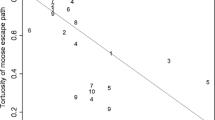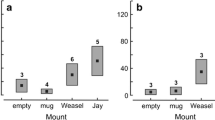Summary
Free-living cheetah (Acinonyx jubatus) cubs are killed by a number of predators, thus vigilance in cheetah mothers may be a form of anti-predator behaviour as well as a means of locating prey. Mothers' vigilance during the day was closely associated with measures of hunting but not with measures of anti-predator behaviour. In contrast, mothers' vigilance at kills was not related to hunting but was related to anti-predator behaviour. Both forms of vigilance decreased as cubs grew older. Vigilance during the day increased with litter size which supports a model of ‘shared’ parental investment (Lazarus and Inglis 1986) because after prey had been located and caught by mothers, cubs shared the prey between them. Vigilance at kills did not increase with litter size when cubs were young; in these situations predators stole cheetahs' prey and rarely chased cubs so, at most, only a single cub would be taken. Mothers' anti-predator behaviour away from kills did increase with litter size at young cub ages however; more cubs are killed in these circumstances the greater is the size of the litter. When cubs were older and could outrun predators, neither vigilance at kills nor anti-predator behaviour increased with litter size. These results strongly support two models of ‘unshared’ investment (Lazarus and Inglis 1986) and demonstrate, not only that superficially similar behaviour has different functions in different contexts, but that parental investment is shaped by the type of benefits accrued from it.
Similar content being viewed by others
References
Ammann K, Ammann K (1984) Cheetah. Camerapix Publ Int, Nairobi
Andersson M, Wiklund CG, Rundren H (1980) Parental defense of offspring: a model and an example. Anim Behav 28:536–542
Bertram B (1978) Pride of lions. Dent & Sons, London
Bertram BCR (1980) Vigilance and group size in ostriches. Anim Behav 28:278–286
Best GA, Edmond-Blanc F, Witting RC, Raw WG (1962) Rowland Ward's Records of Big Game XIth Edition (Africa). Rowland War Ltd, London
Burney DA (1980) The effects of human activities on cheetahs (Acinonyx jubatus Schr.) in the Mara Region of Kenya. Msc Thesis, University of Nairobi
Burney D, Burney L (1979) Cheetah and man. Swara Magasine 2(3):28–32
Cade R (1965) Cheetah just tolerate humans. Africana 2(4):33–35
Caro TM (1982) A record of cheetah scavenging in the Serengeti. Afr J Ecol 20:213–214
Caro TM (1986) The functions of stotting in Thomson's gazelles: some tests of the predictions. Anim Behav 34:663–684
Caro TM (1987) Indirect costs of play: cheetah cubs reduce maternal hunting success. Anim Behav 35:295–297
Caro TM, Collins DA (1986) Male cheetahs of the Serengeti. Nat Geogr Res 2:75–86
Caro TM, Collins DA (1987a) Ecological characteristics of territories of male cheetahs (Acinonyx jubatus). J Zool 211:89–105
Caro TM, Collins DA (1987b) Male cheetah social organization and territoriality. Ethology 74:52–64
Caro TM, Holt ME, FitzGibbon CD, Bush M, Hawkey CM, Kock RA (1987) Health of adult free-living cheetahs. J Zool (in press)
Dunbar RIM, Dunbar EP (1980) The pairbond in klipspringer. Anim Behav 28:219–229
Eaton RL (1970) Group interactions, spacing and territoriality in cheetahs. Z Tierpsychol 27:481–491
Eaton RL (1974) The Cheetah: The biology, ecology, and behaviour of an endangered species. Van Nostrand Reinhold, New York
Frame G, Frame L (1976) The vulnerable cheetah. Expedition VI (6):40–46
Frame GW, Frame LH (1977) Serengeti cheetah. Wildlife News 12(3):2–6
Frame G, Frame L (1981) Swift enduring: Cheetahs and wild dogs of the Serengeti. Dutton, New York
Graham AD, Parker ISC (1965) East African Wild Life Society cheetah survey, report by Wildlife Services. East African Wildlife Society, 25 p mimeo
Guggisberg CAW (1962) Simba, the life of the lion. Bailey Bros. & Swinfen, London
Houston DC (1974) Food searching behaviour in griffon vultures. E Afr Wildl J 12:63–77
Iwago M (1986) The Serengeti: A portfolio. Nat Geog 169(5):560–583
Kingdon J (1977) East african mammals: An atlas of evolution in Africa. Vol. III. Pt. A (Carnivores). Academic Press, New York
Kruuk H (1972) The spotted hyaeana. University of Chicago Press, Chicago
Kuenkel R (1978) Cheetahs — swift cats of the Serengeti. Geo Magazine 1:94–110
Lamprecht J (1978) The relationship between food competition and foraging group size in some larger carnivores. Z Tierpsychol 46:337–43
Lazarus J, Inglis IR (1978) The breeding behaviour of the pink-footed goose: parental care and vigilant behaviour the fledging period. Behaviour 65:62–88
Lazarus J, Inglis IR (1986) Shared and unshared parental investment, parent-offspring conflict and brood size. Anim Behav 34:1791–1804
Lienhardt G (1961) Divinity and experience: The religion of the dinka. Clarendon Press, Oxford
Leyhausen P (1979) Cat behavior: The predatory and social behavior of domestic and wild cats. (Transl by BA Tonkin). Garland, New York
Maugham RCF (1914) Wild game in Zambezia. Charles Scribner's sons, New York
McLaughlin RT (1970) Aspects of the biology of cheetahs Acinonyx jubatus (Schreber) in Nairobi National Park. Msc thesis, University of Nairobi
McVittie R (1979) Changes in the social behaviour of South West African cheetah. Madoqua 11:171–184
Myers N (1975) The cheetah (Acinonyx jubatus) in Africa. IUCN Monograph No. 4. IUCN, Morges, Switzerland
O'Brien SJ, Wildt DE, Bush M (1986) The cheetah in genetic peril. Sci Am 254(5):68–76
Packer C (1986) The ecology of sociality in felids. In: Rubenstein DI, Wrangham RW (eds) Ecological aspects of social evolution. Princeton University Press, Princeton, pp 429–451
Packer C, Pusey AE (1982) Cooperation and competition within coalitions of male lions: kin selection or game theory? Nature 296:740–742
Packer C, Pusey AE (1984) Infanticide in carnivores. In: Hausfater G, Hrdy SB (eds) Infanticide: comparative and evolutionary perspectives. Aldine, New York, pp 31–42
Pienaar U de (1969) Predator-prey relations amongst the larger mammals of Kruger National Park. Koedoe 12:108–176
Pocock RI (1932) Exhibition of a young cheetah skin. Proc Zool Soc Lond 844–845
Robertson RJ, Biermann GC (1979) Parental investiment strategies determined by expected benefits. Z Tierpsychol 50:124–128
Schaller GB (1967) The deer and the tiger. University of Chicago Press, Chicago
Schaller GB (1972) The Serengeti Lion. University of Chicago Press, Chicago
Sinclair ARE (1979) The Serengeti environment. In: Sinclair ARE, Norton-Griffiths M (eds) Serengeti: dynamics an ecosystem. University of Chicago Press, Chicago, pp 31–45
Taylor RC, Rowntree VJ (1973) Temperature regulation and heat balance in running cheetahs: a strategy for sprinters? Am J Physiol 224:848–854
Author information
Authors and Affiliations
Rights and permissions
About this article
Cite this article
Caro, T.M. Cheetah mothers' vigilance: looking out for prey or for predators?. Behav Ecol Sociobiol 20, 351–361 (1987). https://doi.org/10.1007/BF00300681
Received:
Accepted:
Issue Date:
DOI: https://doi.org/10.1007/BF00300681




